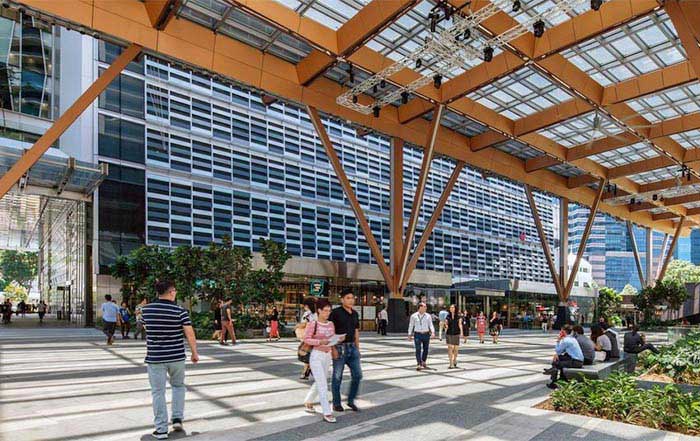Singapore has stunning skyscrapers and exciting architectural styles. However, because of the proximity to Changi Airport, there is a height restriction for any structure created, which the owners and architects must adhere to. This list outlines some of the prominent, must-see structures that Singapore has in store for all visitors.
Tanjong Pagar Centre- Tanjong Pagar Centre, also known as Guoco Tower and located in 'Tanjong Pagar,' is now Singapore's highest building. The building's height, 290m, exceeds the height limit for structures in Singapore- however, the government exempted it from the limitation owing to its position, which does not interfere with flight patterns. The development began in 2013 and was finished in 2016, breaking the record by UOB Plaza, Republic Plaza and One Raffles Place, for being the highest buildings- with a height of 280m.
Marina Bay Sands- Nothing in Singapore thus far can compete with Marina Bay Sands in terms of design and location since it fronts Marina Bay and all this world-class integrated resort has to offer. The architectural style appears to be inspired by decks of cards, with three major towers that are wider at the base and connected by a lobby. Sands SkyPark, with a 150m swimming pool, gardens, and running pathways on the top of the complex, is one of the Hotel's distinguishing characteristics.
Shenton Way – Also known as AXA Tower- This tower, with a height of around 235m and 16 Double Decker elevators, is famous for providing a 360-degree bird's eye perspective of the business center. This commercial complex's structure is made up of steel beams that took nearly four years to build. Capital Land sold it to MPGA in 2007 for around S$1.04 billion.
Capital Tower - Capital Tower, Singapore's fourth-tallest skyscraper, has 52 floors. This 254m tall tower is served by five shuttle double-deck elevators and stands out aesthetically at night when specific areas of the structure undergo a lighting shift every few seconds. When it was authorized as the company's main building, it was dubbed 'Capital Tower.'
Ocean Financial Centre- Ocean Financial Center, an epicenter of several financial businesses in the city, encourages the use of sustainable energy (Solar Energy) by exhibiting a large 'solar array.' This skyscraper, at 245m tall, is the eighth-tallest structure in the city-state and took around three years to complete. The structure was built to replace the Ocean Building, which was destroyed in 2007.
Pearl Bank- Pearl Bank, often known as the Death Star among architecture students, is regarded as one of the best works by the pioneering architects of the mid-twentieth century. The façade conceals all of its complexity, and merely gazing at it does not reveal the interlocking of split-level apartments throughout each story. When it was built in 1976, this was the highest and densest residential building in Singapore, standing at around 113 meters. The fundamental notion was to build the complex in such a way that the facade area exposed to direct sunlight was greatly decreased.
The Interlace- Despite its moderate height, roughly 90 meters, this is one of the trendiest complex buildings in Singapore, with over 1000 units on 25 floors, designed by OMA and Ole Scheeren.It's an attractive complex for its contemporary style architectural design, which resembles 31 bricks irregularly stacked upon each other, similar to Jenga blocks, and is fully equipped with facilities such as swimming pools, gymnasium, tennis and basketball courts, karaoke rooms, and playgrounds for children, offering convenience to residents. This is among the city-most state's ambitious residential complexes, with a distinct housing ideology, and it took around six years to complete.
Tree House, Bukit Timah- Tree House, the world's largest vertical garden, is an eco-friendly condominium that entered the Guinness Book of Records; this was in 2014. Why? For its creatively constructed, sheer scaled construction. The vertical garden significantly decreases the estate's carbon footprint and hence global warming since it minimizes the energy needed to cool internal spaces and is fitted with additional modern amenities such as heat-reducing windows and proximity sensors (for lighting) in public areas. Apart from the recreational swimming pool, Tree House also has a Rain spa and an Aqua-gym. It's among the most remarkable buildings in Singapore.

